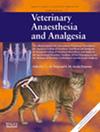Cardiorespiratory effects of gamma-hydroxybutyric acid during isoflurane anaesthesia in pigs
IF 1.4
2区 农林科学
Q2 VETERINARY SCIENCES
引用次数: 0
Abstract
Objective
To investigate the haemodynamic effects of gamma-hydroxybutyric acid (GHB) in isoflurane-anaesthetized pigs.
Study design
Experimental, randomized, nonblinded, crossover study.
Animals
A group of six stress-resistant Landrace pigs (approximately 3 months old; three male, three female; bodyweight 39.2 ± 4 kg, mean ± standard deviation).
Methods
After premedication (midazolam 0.5 mg kg–1 and ketamine 10 mg kg–1 intramuscularly) and induction [propofol 0.25–0.5 mg kg–1 intravenously (IV)], anaesthesia was maintained with isoflurane in oxygen, and either GHB 250 mg kg–1 IV or an equal volume of saline was administered (minimum washout period 1 week). Systolic (SAP), diastolic (DAP) and mean (MAP) arterial pressures, heart rate and rhythm and respiratory rate were recorded every 5 minutes for 2 hours. Arterial samples were collected for blood gas and pharmacokinetic analyses. Relative changes from baseline were calculated and compared between treatments using a mixed model with time, period and treatment as variables (α < 0.05).
Results
Changes from baseline differed significantly between treatments (p < 0.001) for SAP (GHB –1.6 ± 10.7; saline –5.9 ± 14.8 mmHg), DAP (GHB +2.9 ± 9.6; saline –6.5 ± 10.7 mmHg) and MAP (GHB +2.2 ± 10.5; saline –5.7 ± 9.6 mmHg). Statistical analysis of secondary outcomes suggested effects on PaO2 [GHB –45.2 ± 29.8 mmHg (–6.03 ± 3.97 kPa); saline +24.5 ± 32.4 mmHg (+3.27 ± 4.32 kPa); p < 0.001] and PaCO2 [GHB –2 ± 10 mmHg (–0.27 ± 1.33 kPa); saline –9 ± 8 mmHg (–1.20 ± 1.07 kPa); p < 0.001]. Mean maximum blood concentration of GHB was 1171.1 ± 229.3 μg mL–1, with volume of distribution 335.3 ± 68.5 mL kg–1, clearance 77.2 ± 19.12 mL kg–1 hour–1 and elimination half-life 3.10 ± 0.80 hours.
Conclusions and clinical relevance
GHB did not cause severe physiological side effects and may reduce cardiovascular depression.
异氟醚麻醉期间γ -羟基丁酸对猪心肺功能的影响。
目的:研究γ -羟基丁酸(GHB)对异氟醚麻醉猪血流动力学的影响。研究设计:实验、随机、非盲、交叉研究。动物:一组6头抗压力长白猪(约3个月大;三男三女;体重(39.2±4 kg,平均值±标准差)。方法:在给药前(咪达唑仑0.5 mg kg-1,氯胺酮10 mg kg-1肌注)和诱导后(异丙酚0.25 ~ 0.5 mg kg-1静脉注射(IV)),异氟醚氧维持麻醉,并给予GHB 250 mg kg-1静脉注射或等量生理盐水(最短洗脱期1周)。每5分钟记录一次收缩压(SAP)、舒张压(DAP)和平均动脉压(MAP)、心率、节律和呼吸频率,持续2小时。采集动脉标本进行血气和药代动力学分析。采用以时间、周期和治疗为变量的混合模型计算与基线的相对变化(α < 0.05)。结果:SAP治疗组与基线相比差异显著(p < 0.001) (GHB -1.6±10.7;生理盐水-5.9±14.8 mmHg), DAP (GHB +2.9±9.6;生理盐水-6.5±10.7 mmHg)和MAP (GHB +2.2±10.5;生理盐水-5.7±9.6 mmHg)。统计分析显示次要结局对PaO2 [GHB]有影响-45.2±29.8 mmHg(-6.03±3.97 kPa);生理盐水+24.5±32.4 mmHg(+3.27±4.32 kPa);p < 0.001]和PaCO2 [GHB -2±10 mmHg(-0.27±1.33 kPa);生理盐水-9±8 mmHg(-1.20±1.07 kPa);P < 0.001]。GHB平均最高血药浓度为1171.1±229.3 μg mL-1,分布容积为335.3±68.5 mL kg-1,清除率为77.2±19.12 mL kg-1小时-1,消除半衰期为3.10±0.80小时。结论及临床意义:GHB无严重的生理副作用,可减轻心血管抑郁。
本文章由计算机程序翻译,如有差异,请以英文原文为准。
求助全文
约1分钟内获得全文
求助全文
来源期刊

Veterinary anaesthesia and analgesia
农林科学-兽医学
CiteScore
3.10
自引率
17.60%
发文量
91
审稿时长
97 days
期刊介绍:
Veterinary Anaesthesia and Analgesia is the official journal of the Association of Veterinary Anaesthetists, the American College of Veterinary Anesthesia and Analgesia and the European College of Veterinary Anaesthesia and Analgesia. Its purpose is the publication of original, peer reviewed articles covering all branches of anaesthesia and the relief of pain in animals. Articles concerned with the following subjects related to anaesthesia and analgesia are also welcome:
the basic sciences;
pathophysiology of disease as it relates to anaesthetic management
equipment
intensive care
chemical restraint of animals including laboratory animals, wildlife and exotic animals
welfare issues associated with pain and distress
education in veterinary anaesthesia and analgesia.
Review articles, special articles, and historical notes will also be published, along with editorials, case reports in the form of letters to the editor, and book reviews. There is also an active correspondence section.
 求助内容:
求助内容: 应助结果提醒方式:
应助结果提醒方式:


